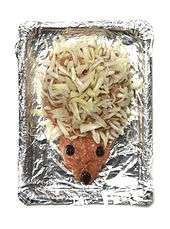Mett


.jpg)
Mett is a preparation of minced raw pork that is popular in Germany, in Belgium and the Netherlands a similar preparation is made from beef. The name originates from mett, either meaning "chopped pork meat without bacon", or the Old Saxon meti, meaning "food". It is normally served with salt and black pepper, and sometimes with garlic, caraway or chopped onion, and eaten raw, usually on a bread roll. At a buffet it is sometimes served as a mettigel (mett hedgehog). it is also sold in the form of Mettwurst, a spicy, raw sausage, often smoked. In Germany, laws require that no more than 35% of the mett is constituted by fat.
Description
The name is derived from Low German mett for "chopped pork meat without bacon", or Old Saxon meti for "food". It is also known as Hackepeter (Northern Germany, Eastern Germany and Berlin). It consists of minced pork meat, normally sold or served seasoned with salt and black pepper, regionally also with garlic or caraway, and eaten raw. It is also permitted to add chopped onion, in which case it is known as Zwiebelmett (onion Mett). Legally, German Mett is not allowed to contain more than 35% fat.[1] Unless pre-packaged, the German Hackfleischverordnung ("minced meat directive") permits mett to be sold only on the day of production.
Varieties
Schinkenmett ("ham Mett"), prepared from the upper thigh (ham), is considered especially fine.
In contrast to the normally available locally minced Mett, coarse pork Mett (Grobes Schweinemett) is produced in an industrial meat grinder. To preserve its structure, the pork meat is normally processed in a semi-frozen state. The "minced meat directive" does not permit temperatures over 2°C; ice may not be used for cooling.
Serving styles
Raw Mett is normally eaten on bread rolls (Mettbrötchen) or sliced bread, frequently with a garnish of raw onion rings or diced raw onion.
At buffets, Mett is occasionally served as a Mettigel (Mett hedgehog, also Hackepeterigel or Hackepeterschwein). This form of serving Mett was especially popular in the 1970s. To produce it, a large amount of Mett is shaped as a hedgehog, quartered onion rings or pretzel sticks are used as spikes, olives as eyes and nose.
In parts of Southern Germany Mett (Mettstange) is served on a Lye roll instead of a regular bread roll.
Sausage
Mett can be made extremely durable in the form of Mettwurst, a spicy and frequently smoked raw sausage.
See also
| Wikimedia Commons has media related to Mett. |
References
- ↑ Deutsches Lebensmittelbuch für Fleisch und Fleischerzeugnisse